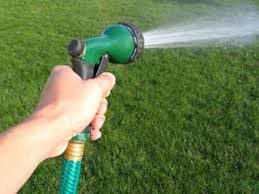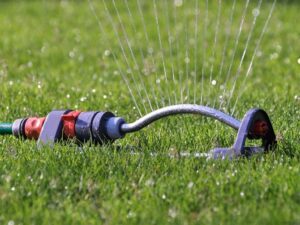A newly laid lawn does need a little care while it establishes in its new environment. Turf can lose moisture quickly, sometimes in under 2-3 hours after being laid, which is why it’s important that it is watered. Water stimulates the roots to grow and spread which is why the grass plants in a new lawn requires water to thrive.
Day 1
 Immediately after laying, turf needs a thorough watering, making sure the water reaches approximately 25mm below the surface of the soil; there’s no need to water deeper than that at this stage. A hose with a spray attachment can be used, or a sprinkler, moved around the lawn. Alternatively, pop-up sprinklers can be added to the lawn area before laying. Whichever method is used, make sure that the corners and edges of the turf given most attention as they can dry out more quickly.
Immediately after laying, turf needs a thorough watering, making sure the water reaches approximately 25mm below the surface of the soil; there’s no need to water deeper than that at this stage. A hose with a spray attachment can be used, or a sprinkler, moved around the lawn. Alternatively, pop-up sprinklers can be added to the lawn area before laying. Whichever method is used, make sure that the corners and edges of the turf given most attention as they can dry out more quickly.
The depth that the water has reached can be checked by gently lift the corners of the turf and using a kitchen knife to dig a small hole in the soil; the watered depth will appear darker than the soil below it. Using anything too large to dig the hole could disturb the level ground too much.
Important note:
Only the roots of grass plants absorb water, which is why it is important to check that water has soaked down through the soil even when the leaves of the lawn appear to be wet, however there is no need to overdo it.
Day 2 onwards
There is watering guidance available which suggests a regimented routine. Although this isn’t necessarily incorrect, we believe that, once turf has had its first good watering on day one, it is better to judge how much watering is required on a case-by-case basis, depending on local conditions. This may be once or twice daily in warmer or windier weather, but at other times of the year it is more likely that watering will be required less frequently, for example if the turf is laid during a cooler, rainy season. Adopting this method maximises water usage.
Important note:
When the turf gets to the stage that it can’t be lifted and it’s less clear how much water is required, the soil’s moisture can be tested by pushing a clean, dry screwdriver through the soil, down to a depth of at least 100mm. If it pushes easily and when removed comes out clean, then the soil is moist. However, if there is a lot of resistance when pushing the screwdriver into the soil and when withdrawn it has a powdery residue, it is likely that the soil is too dry and requires a little water.
How to water turf
In warm weather it is best to water a lawn in the evening; if this isn’t possible, early morning while it is still cool is the next best option. This helps to reduce lost water through evaporation and gives the grass roots a longer period to absorb the water before the ground starts to increase in temperature.
- Download an app to monitor the weather in the local area over the next couple of days. Taking the forecasted weather conditions into account can help determine the best time to water a garden. For example, if the temperature will be particularly high the next day it may be wise to water the new turf the evening before, or if there is rain forecast overnight the lawn may not need to be watered.
- Don’t forget that the soil needs to be wet, so morning dew on the plants’ leaves is not enough.
- If the soil base looks dry, or the turf is showing signs of shrinkage or browning then this may indicate the need for more frequent watering.
- On rare occasions, such as during a heatwave, new turf may need to be watered more than once per day, however this should only be done where absolutely necessary.
As we mentioned earlier, during the first few days, it is advisable to continue to lifting the corners of the turf to check whether the water is reaching the soil below. It is important to lift gently so that any roots that have started to grow into the soil underneath the turf are not damaged. If there is any resistance this could be a sign that the turf already has roots growing into new soil, so take care not to damage them.
Signs of underwatering in new turf
- Yellowing of the turf.
- Blades of grass withering.
- Brown, dried edges.
- New turf showing signs of shrinkage after laying.
- When the lawn is walked upon footprints remain as the grass leaves don’t spring back to an upright position.
- Audible crunch; this is usually only when severely underwatered and completely dried out; at this stage it is likely that the turf will be brown and look very dry. If the grass plants have reached this stage there is a very slight chance they may still recover if the roots are still alive, but after two or three days of watering if there is no further growth then it is highly likely you will need to replace the lawn.
Important note:
Watering is more important for newly laid turf than established lawns, as water encourages root growth and avoids shrinkage, but remember to use water responsibly and don’t set sprinklers on a timer, as watering may not be necessary every day and sprinklers should be switched off as soon as the area has received sufficient water for the turf’s requirements.
How to tell if newly laid turf is overwatered
Most people underwater rather than overwater turf, but it is possible to overdo it. The clearest signs of overwatering are:
- Pools of water on the surface, or the ground feels soggy when walked upon.
- The grass starts to turn a lighter green or yellow. This is due to the roots being suffocated and the excess water leaching nutrients from the soil.
- Shallow roots after a number of weeks of being laid; the grass plants learn that they don’t need to grow deep roots to find water if the lawn is watered too regularly. This can result in a weak lawn, more susceptible to traffic wear and disease.
The soil doesn’t need to be saturated, just given enough so that the water soaks through the new turf to the soil below to encourage the roots to grow down. As well as overwatering being inefficient, it can be detrimental to the health of the new lawn.
If a lawn is overwatered and water is sitting on the surface, using a garden fork to spike holes in the turf to a depth of at least 100mm can help the water penetrate and drain deeper into the soil below. Refrain from watering turf until the water has fully drained and the soil’s moisture has been assessed, using the screwdriver test mentioned earlier.
Mature turf is fairly resilient to drought, so if it doesn’t receive water and turns brown in areas try to keep off the lawn to avoid the roots being damaged; it is likely the turf will recover once the cooler, wet weather arrives.
We hope you have found this article interesting. If so, please feel free to share on Facebook, Twitter and Pinterest. If you would like to stay up-to date with our news, advice and special offers, why not sign up to our newsletter.

